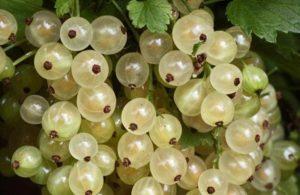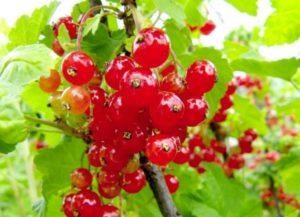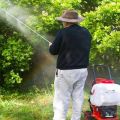How can you feed currants in autumn, spring and summer for a better harvest
Those summer residents on whose plots shrubs grow sometimes do not understand what their plants lack. They think about the question of what experienced gardeners feed the currants, what to bring and how to do it correctly. There are many nuances, but it will not be difficult to deal with them.
How to understand when plants are lacking fertilizer
Experienced summer residents understand this problem by simply looking at the appearance of the plants. With a shortage of elements, crops develop signs by which they determine what exactly black, red and other types of currants are missing.
Signs of missing items:
- The leaves begin to shrink and lose color, become paler. The plant practically does not bloom, growth is inhibited. The foliage turns yellow early, becomes red and orange. These signs indicate a nitrogen deficiency.
- The foliage takes on a bronze tint, fades. The petioles and veins turn reddish. The bushes do not bloom or bear fruit. Leaves fall early. Phosphorus must be added.
- The green mass turns pale, acquiring a purple hue. The edges of the leaves curl up and fall down, begin to dry out. There is deformation, curl on the leaves. Currants lack potassium.
- The ovary and leaves begin to fall off. The tops of the shoots die off and dry up. The root system inhibits development, new shoots are not formed, the old ones become thicker. Plants need calcium.
- Leaves turn yellow and discolored. The harvest decreases, the leaves die off. Iron must be added.
When growing currants, a gardener should carefully monitor the appearance of plants. The signs of deformity that appear on the bushes do not always mean illness. Plants sometimes signal a lack of nutrients.

Fertilization methods
For some summer residents it takes several years to find the best way. Even an experienced gardener makes mistakes in growing. During a certain period, a different method of fertilization is used.
Foliar
The plant absorbs nutrients faster through the foliage. For such feeding, complex mineral fertilizers are used. They are dissolved in water and sprayed with currant bushes.
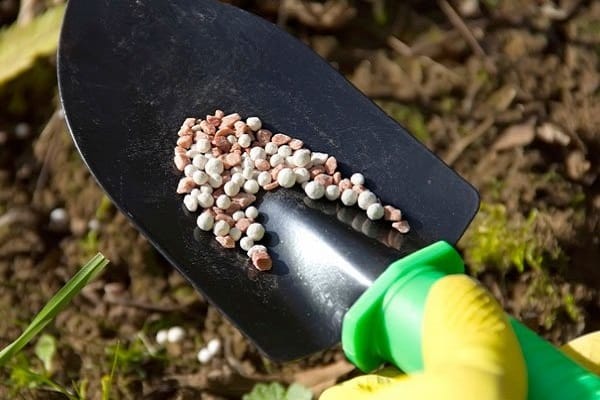
It is not necessary to process plants only by the foliar method; it is necessary to alternate with root fertilizers.
Summer residents mix several drugs and spray them with bushes for prevention. This preventive treatment helps avoid nutrient deficiencies.
Root
Watering with fertilizers at the root is most common. Gardeners water the currants with diluted preparations, use folk remedies and organics. In addition, dry substances are laid out under the roots, which are also top dressing.
An important condition for feeding is strict adherence to instructions and dosage. Otherwise, the plant dies from an excess of nutrients or ceases to bear fruit.
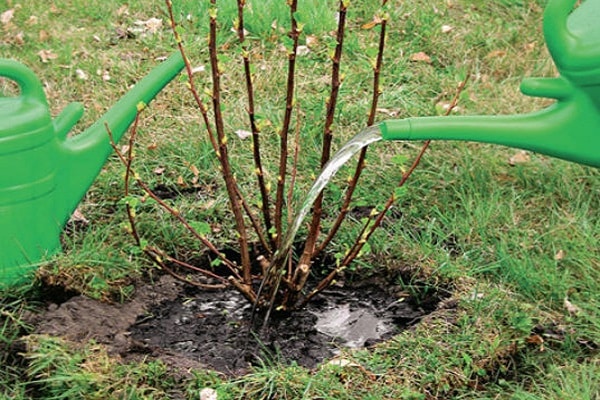
What time to fertilize the bushes
Each feeding has its own term. It is necessary not to miss the favorable period for fertilization.
In the springtime
Summer residents are advised to alternate the methods of feeding. After the snow melts in spring, the soil is moist, so dry top dressing is used. Fertilizer with a high nitrogen content is required.
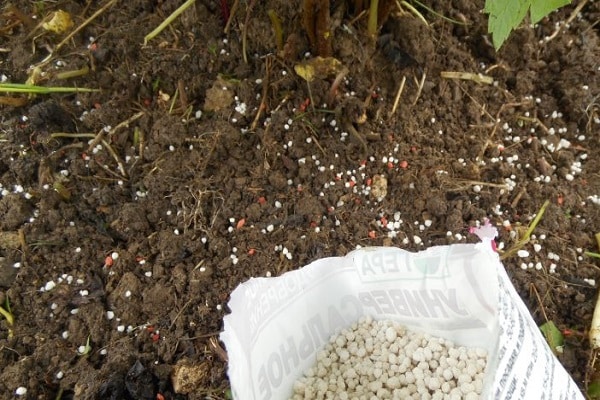
Nitroammofoska, calculation for 1 bush:
- depending on size 10-15 g for black currant;
- also 7-10 g for red currants.
Dry feeding with urea:
- plants from 2 to 4 years old 50 g;
- older - 25 g, no longer recommended.
Currants at the age of 4 years practically do not need nitrogen. The growth of the bush is complete, so the consumption of the substance is reduced.
Nitrogen is contained in wood ash, its introduction under each bush will replace urea and other chemicals.
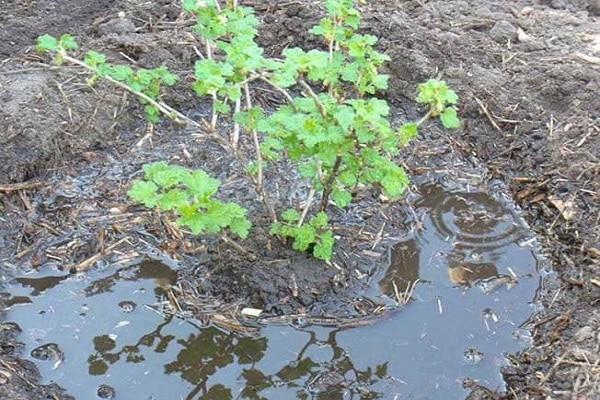
On a green leaf
Long growing season of the plant. At this time, different fertilizers are applied, always alternating them. In July, during flowering, it is advisable to limit foliar feeding, as some substances that they collect with pollen harm the bees.
The plant spends a lot of energy on the formation of the ovary, with a lack of useful elements, the berries can be small, tasteless or bitter. In summer, currants are fed with potassium and phosphorus. Fertilizers containing nitrogen are not excluded, only the dosage is reduced during the fruiting period.
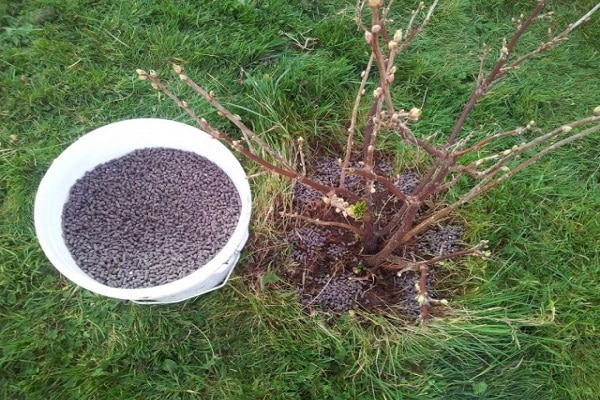
At this time, the plants need organic matter, they are fed by the root method. Prepare the infusion:
- 10 liters of water;
- 1 liter mullein.
Mix well and water the bushes, one bucket is enough for 1 m2.
During the ripening period, summer residents recommend stopping feeding. They are renewed after harvest.
In August, some summer residents begin to feed the currants in the winter, so that the plants receive the nutrients necessary for wintering earlier. Minerals, folk remedies or organics are used.
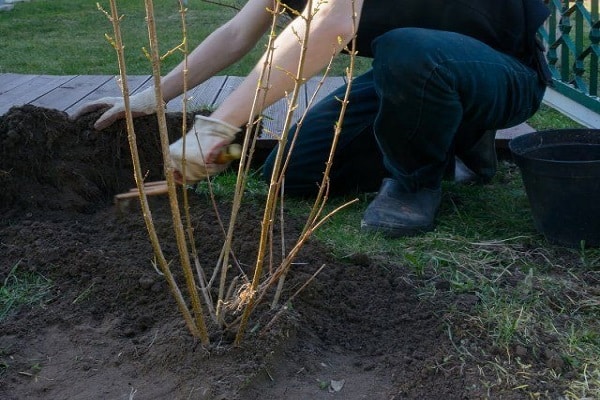
Before wintering plants
Top dressing is carried out in the fall. After fruiting, the currants are weakened and needs to be fed with nutrients. Plants require phosphorus and potassium.
Before wintering, 2 buckets of compost are added under each bush. As a dry top dressing, use granules of the drug HB-101. Its purpose is to stimulate growth, strengthen immunity.
Autumn feeding is carried out with the following composition:
- 40 g of ammophos;
- 100 g of ash;
- 10 liters of water.

Stir thoroughly and bring under each bush. Young ones need 2 liters, older bushes need 5 liters of nutrient mixture to feed them.
Any top dressing is carried out on wet soil, otherwise minerals can burn the root system, the bush will die. After cultivation, the soil is loosened and covered with a layer of mulch.
The nuances of feeding different types of currants
Each type of currant has its own characteristics. The culture is one, but there are still small differences. To have a good harvest of berries, it is necessary to properly feed the plants.
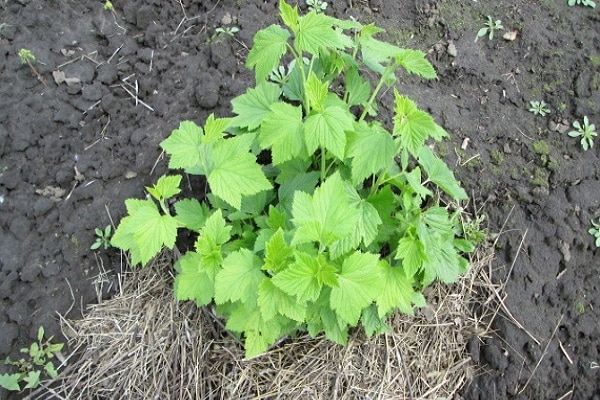
Black currant bushes are not fertilized as intensively. This is due to the fact that plants have a poorly developing root system; it slowly absorbs nutrients from the soil. Therefore, if the bush has been growing in one place for more than 6 years, feeding is stopped or minimized.
Red and white currants develop much faster, their root system is formed at depth. Therefore, for efficiency, root dressing is carried out using a moat around the plants. This is how they achieve greater efficiency.
Feeding golden currants is not an easy process. She is very demanding on the composition of the soil. Therefore, dosed regular application of complex fertilizers is required.

Complex fertilizers
To facilitate the work of gardeners, manufacturers produce mixed plant foods. The main elements included in the composition:
- nitrogen;
- potassium;
- phosphorus.
But the summer resident should be careful when purchasing a complex fertilizer. They are subdivided into spring and autumn. The difference is in the amount of nitrogen: a lot for spring, less for summer and autumn.
Phosphoric
These fertilizers are needed for currants during flowering, ovary formation, fruiting and laying fruit buds for the next year.
The most commonly used drug is superphosphate. In the fall, 1 tbsp is placed under each bush. spoon of substance. Top dressing is dry in rainy weather or liquid in dry weather.
If desired, potassium is added to the phosphate, which is also necessary for plants.

Organic
A special part of dressings is organic. Use all the tools at hand. They are brought in mainly in the spring. But summer residents spread compost or horse manure in the roots of the currant as a heater for the roots. Do this after the ground is frozen.
This protects the roots from freezing, and in the spring, after the snow melts along with moisture, nutrients will enter the soil.
Rotten manure
They are introduced into the soil, fertilizing the soil near the plants. Approximately 1-2 buckets per bush. Then cover with a layer of mulch, protecting it from drying out.
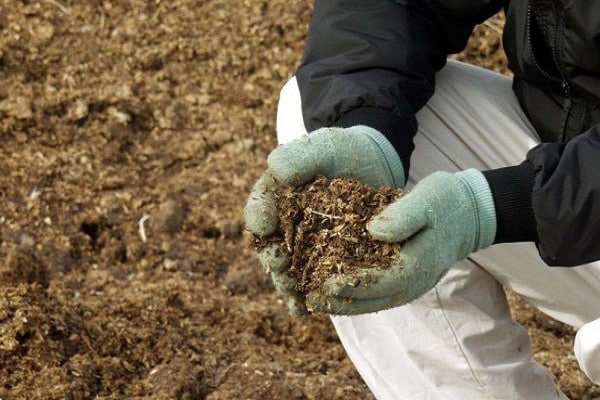
Bird droppings
It is brought under a bush for digging in a dry form. 1 kg per plant. The fertilizer is thoroughly mixed with the ground, since direct contact with the root system can get burned. The embedding depth is 15-25 cm. Some gardeners make liquid fertilizing by diluting chicken manure in a ratio of 1:15.
Compost and humus
These fertilizers do not contain nitrogen, therefore they are used during summer plant fertilization. They are often used as a layer of mulch, laid out under the bush in a layer of 1 cm.
Urea
It is applied in spring, embedded in the soil in wet weather. Or diluted with water when dry.
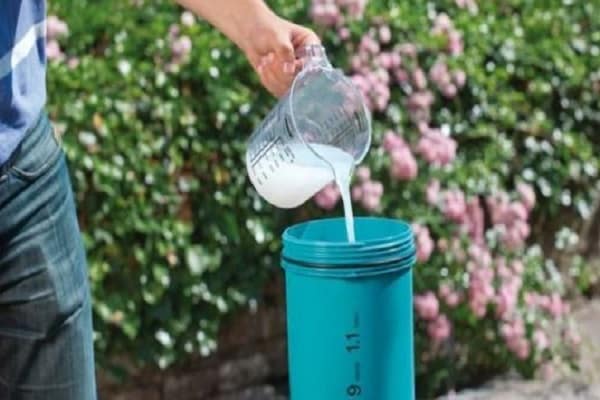
Potato peelings for currants
The starch contained in potato peelings is used to feed currants. To do this, take water, a bucket of potato peelings, bring to a boil and allow to stand until completely cooled.
Then the resulting mixture is watered with currant bushes. Approximately 3 liters per plant.
The second option for preparing the infusion. Take 1: 1 water and purification, fill it with warm water and let it stand for 30-45 days. The resulting fertilizer is filtered and diluted with water in a ratio of 1:10. Water 1 bush with 1 bucket.
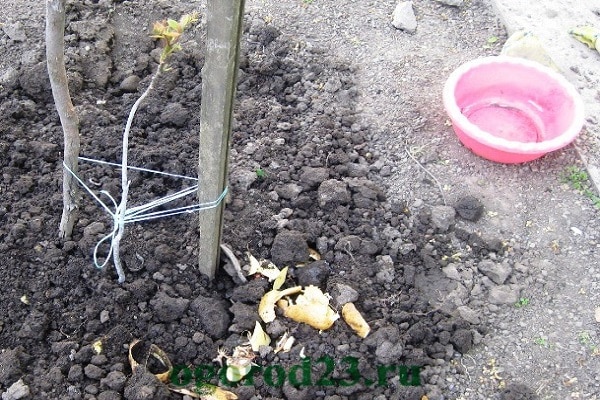
Folk remedies for fertilizing currants
Connoisseurs of healthy vegetables and fruits strive to do without the use of chemicals on the site. But currants need minerals. Without them, there will be no harvest, the plants even die.
Use ordinary starch as a top dressing. Pour 200 g with 5 liters of water, bring to a boil. Dissolve the resulting mixture in a bucket of water, pour over the bushes with currants. Use 2 liters of liquid per plant.
Bread crusts are used as top dressing. Pour water in a ratio of 1: 1, let stand for 2 weeks. Then diluted with water at the rate of 1:10, water the bushes.
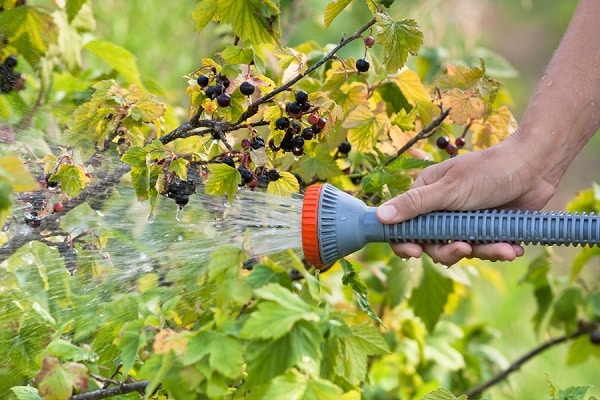
Nitrogen fertilizers
They are purchased in the store, used organic or wood ash. Used as a top dressing in the spring. In summer, it is advisable to use less, so that the plants form ovaries, and not leaves and shoots.
Fertilizing currants with mineral fertilizers
Complex fertilizing with mineral compositions is used in spring and autumn. Only the percentage of substances is slightly different. It is important not to overdo it, since an excess of any substance will lead to improper development and even death of plants.
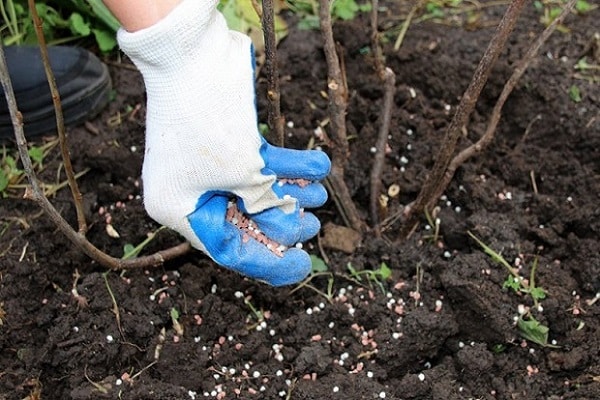
Feeding currants with ash
The effect of using wood ash is great, since it contains both nitrogen and potassium. Wood ash is a folk fertilizer.
The first time ash is added to the soil during planting. Then it is applied every year before flowering. The following rate is calculated:
- for 1 bush of black currant, 150 g of the substance is enough;
- for all other varieties the maximum amount is 200 g.
Use wood ash as a dry top dressing or dilute with water and water the bushes at the root.
Top dressing is an important process in growing currant varieties. It is important to take into account the norm without being guided by the principle: the more the better.
